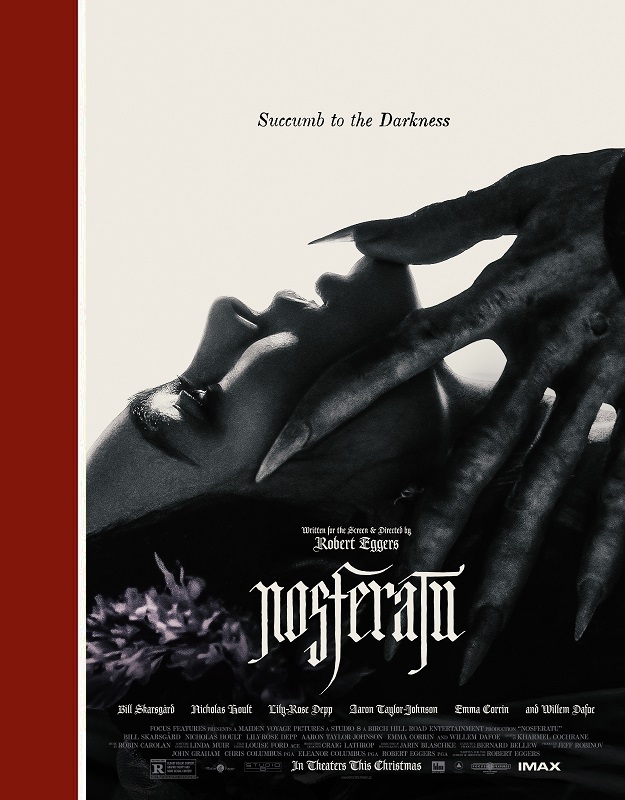

Nosferatu, released worldwide on Christmas Day 2024, is Robert Eggers’ reiteration of German filmmaker F. W. Murnau’s 1922 film Nosferatu: A Symphony of Horror. Muranau’s film is widely regarded as one of the representative films of the German expressionist film movement, and has had an enormous influence on artists and scholars from various fields, turning into somewhat of a cultural artefact. A hundred and two years after its release, Robert Eggers brings to us the third remake of the film (the others being Werner Herzog’s and David Lee Fisher’s 1979 and 2023 versions, respectively).
The original Nosferatu is an adaptation (or, rather, a retelling) of Bram Stoker’s Dracula. When the German film-makers could not get the rights to the novel, they made a few but significant alterations to the story, the most important of them being the replacement of Count Dracula by Count Orlok or Nosferatu. Roger Ebert, reviewing the film in 1997, described the difference as such: ‘Say “Dracula,” and you smile. Say “Nosferatu,” and you’ve eaten a lemon.’ Instead of the charismatic and tragic Count Dracula, Murnau and screenwriter Henrik Galeen gave us the malicious and irredeemable Count Orlok. Remaking such iconic films is always a risky venture and becomes subject to unpopularity, but the task was picked up by Robert Eggers, possibly the most able person to do the job.
Eggers’ Nosferatu is a gothic romance, blended with elements of horror, revolving around the young newly-weds Thomas and Ellen Hutter, whose lives gets threatened by a malicious supernatural entity that seems to have some sort of an inexplicable, spiritual connection with Ellen. The film can also be categorised as a kind of possession horror. In essence, the film explores the consequences of control, the repression of desires, and the trials and tribulations of love.

A feminist text, where the female protagonist becomes the driving force of the narrative, both as a subject and an object.
At the centre of the film is the theme of love, but it is explored differently, where the passion stemming out of love (or from the lack of it) becomes the primary causal agent. Multiple aspects of passion — both benevolent and parasitic — are explored in the film, and the extremities of desire are addressed through the predicament of the characters.
The film can be read as a feminist text, where the female protagonist becomes the driving force of the narrative, both as a subject and an object. She is not only an object of desire, but also a subject that desires. It is her desire that actually sets off the chain of reactions in the story. This aspect gets more emphasis in this film than the original.
The film has magnificent visuals. The cinematographer Karin Blaschke and production designer Craig Lathrop bring Eggers’ vision to life, composing every frame in such a way that it portends the evil looming over the on-screen world. Almost resembling paintings, the colours in the film are subdued and muddy, giving it a monochromatic aesthetic. It works in two ways — from a narratorial standpoint, it resonates with the existence of the evil spirit that has sucked the life out of everyone and everything around it. Secondly, from a technical standpoint, the pallid, muted tones resemble the original film’s black-and-white aesthetics, which facilitated the eeriness brought in by the play of light and shadow. The absence of sunlight and the predominantly grey skies also add to the gloomy atmosphere of the film. Like this, Eggers’ Nosferatu maintains the expressionistic heritage of the original.
Another distinct feature of Eggers’ works is his use of background music, and the feelings of unease and dread in Nosferatu are heightened by the film score, composed by Robin Carolan. From the very first sequence of the film, the sound design immerses us into the narrative, and sets the tone for the sinister journey we are about to embark on. Every footstep, every breath, and even the sounds of clothes rubbing against the skin add to the aural experience, transporting the audience from their comfortable seats into the afflicted world of the film.
Every cast member delivers a powerfully convincing performance. Ellen Hutter is an extremely challenging character to play, given the role’s physical requirements, but Lily-Rose Depp carries out the task with such finesse that it is impossible now to think of anybody else doing the role. There are instances in the film where she depicts a range of completely disparate emotions within a single scene. This is not only Lily-Rose Depp’s best performance till date, but also one of the best acting performances of 2024. Nicholas Hoult as Thomas Hutter does a remarkable portrayal of a psychologically tormented man. Aaron Taylor-Johnson is quite possibly one of the most underrated actors of the present era. Through his performance as Friedrich Harding, he reminds us how he can masterfully pull off challenging roles. William Dafoe, as Professor Albin Eberhart Von Franz, is as great as ever, bringing in life and vigour into an otherwise sordid atmosphere. And then, there is Bill Skarsgard as Count Orlok.
Prior to its release, Nosferatu’s marketing team never revealed any image of Count Orlok, for generating curiosity. Max Schreck’s iconic portrayal of the Count in the 1922 film naturally raised expectations, and garnered speculations. Bill Skarsgard exceeds all expectations, literally becoming Count Orlok, in the sense that the actor seems to get completely taken over by the character. This becomes possible due to the incredible craftsmanship of the make-up and prosthetics department. Skarsgard looks absolutely unrecognisable as the Count, and he goes all in on the role, even taking vocal training from an opera singer to naturally deepen his voice for playing the character. This is one of the few instances where the attempt of replicating (or remodelling) of an iconic character has been successful. We do not have to look far for an instance of a failed revival of a popular character, as it was recently seen in Rupert Sanders’ 2024 remake of Alex Proyas’ The Crow (1994), where Skarsgard himself took on the eponymous role, originally played by Brandon Lee. Skarsgard failed to make an impact as The Crow, but he completely redeems himself as Count Orlok in Nosferatu.
If Murnau’s Nosferatu is a symphony of horror, Eggers’ Nosferatu is a visual poem of horror. With this film, Eggers continues to be one of the uniquely expressive directors in present-day Hollywood.
Aditya Modak
Runner-up of the FIPRESCI-India 2023 competition for the best upcoming film reviewer, he writes for the FCCI Journal of Indian Cinema, and is also the author of a fiction novel, ‘Arachnid’. He is presently doing his PhD in Film Studies at Jadavpur University.

Share Widely

